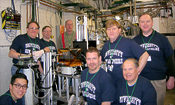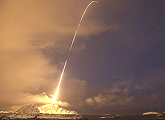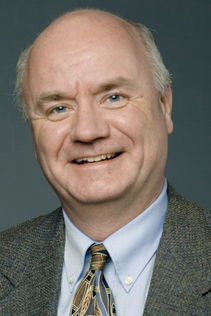Spring 2013
 |
|
| Mount Hunter drill site |
Michael Palace will be a featured speaker at the TEDxPiscataquaRiver conference Friday, May 3 in Portsmouth, N.H. TED, short for Technology, Entertainment, Design, is an international program providing an "immersive environment that allows attendees and speakers from vastly different fields to cross-fertilize and draw inspiration from unlikely places." TEDx programs are local, self-organized events. A tropical ecologist by training, Palace also integrates audio field recordings into electronic music and will talk about the creative process, idea sharing, and interdisciplinary aspects of science.
Jingfeng Xiao coauthored a paper recently published in Environmental Research Letters. The main finding of the study, which was based in southwestern China, is that spring droughts could reduce plant growth and carbon uptake. The paper is featured in environmentalresearchweb.org/.
 |
|
| Ross Gorte |
Ross Gorte joined the ESRC as an affiliate research professor of forest management policy. Gorte is a former senior policy specialist for the Resources, Science, and Industry Division of the Congressional Research Service in Washington, D.C.
Postdoctoral researcher Eric Kelsey won first prize for his poster "A Surprise in the North Pacific: Results From Applying a New Nonlinear Method for Calibrating Ice Cores" presented at the annual American Meteorological Society's 25th Conference on Climate Variability and Change in Austin, Texas. Kelsey is currently director of research at the Mount Washington Observatory and a research assistant professor at the Judd Gregg Meteorology Institute of Plymouth State University.
Chris Hunt attended the ASLO (American Society of Limnology and Oceanography) conference in New Orleans late in February and gave a talk titled "Modeling the export of DOC from large watersheds and its influence on the optical properties of coastal waters." Joe Salisbury (OPAL), Wil Wollheim and Rob Stewart (ESRC) were co-authors.
 |
Historical marine ecologists Karen Alexander and Bill Leavenworth of OPAL and Jeff Bolster of the UNH department of history were featured in the film "Cod Comeback?" broadcast on PBS in February. The film, an episode in the series "Saving the Ocean" hosted and produced by marine biologist and writer Carl Safina, explores the historical collapse of the rich cod fishing grounds of New England and Canada and looks for signs of recovery in the wake of widespread closures in the 1990s. The film can be viewed at http://video.pbs.org/video/2324025884.
Amanda Plagge started a postdoctoral position at the Thayer School of Engineering at Dartmouth College where she did her bachelor's and master's degrees. Plagge is working with a new faculty member who has a background in fluid dynamics and blade/propeller design but who is interested in wind energy—Plagge's topic of interest.
As part of her dissertation work, Ph.D. student Rachel Feeney is interviewing commercial fisherman from the N.H. area in an effort to determine whether the multi-species, groundfish catch-share system that went into effect in May 2010 is achieving theorized benefits. She is evaluating the biological, social, and economic impacts of the management regulations. Feeney is also working full time as a social impact analyst at the New England Fishery Management Council.
Professor Lynn Kistler was named director of the Space Science Center. Kistler succeeds Roy Torbert, who now serves as director of the new Southwest Research Institute-Earth, Oceans, and Space Department (SwRI-EOS) located in Morse Hall.
 |
|
| EHIS calibration team |
Cliff Lopate (principal investigator) and Jim Connell (co-investigator) report that the first flight instrument of the Energetic Heavy Ion Sensor (EHIS) for the first next-generation GOES-R weather satellite was recently tested at National Superconducting Cyclotron Laboratory at Michigan State University and delivered to Assurance Technologies Corporation for environmental testing. EHIS is part of the Space Environment In-Situ Suite (SEISS) for the satellite, which when launched will be the first in a series of four to replace the nation's aging, 30-year-old weather satellites in NOAA's Geostationary Operational Environmental Satellite Program. UNH has been contracted to build four EHIS instruments for the GOES-R, -S, -T, and –U satellites. EHIS, wrapped in protective foil and under nitrogen purge to ensure cleanliness for space operations, is pictured above at the test facility. Team members from left to right (kneeling) are, Dan Tran, Kevin Mello, Frank Kudirka, (standing) Dwayne Rhines, Cliff Lopate, Bruno Pape, Colin Frost, and Jim Connell.
 |
|
| Allison Jaynes |
In January, Allison Jaynes successfully defended her thesis titled "Pulsating Aurora: Source Region & Morphology" and has moved on to a position with the Laboratory for Atmospheric and Space Physics at the University of Colorado. Jaynes is working on high-energy radiation belt physics through analysis of the Van Allen Probes' Relativistic Electron Proton Telescope (REPT) instrument data. REPT is part of the Energetic Particle, Composition, and Thermal Plasma (ECT) instrument suite, which is led by EOS director Harlan Spence.
SSC scientists were part of NASA's latest round of selections for proposed CubeSat missions planned for 2014 launch. UNH, in partnership with Montana State University, will develop components for the Focused Investigations of Relativistic Electron Burst Intensity, Range, and Dynamics (FIREBIRD) II nanosatellite. Ph.D. candidate Alex Crew, along with his advisor and UNH mission lead scientist Harlan Spence, worked with Montana State on the first FIREBIRD mission, which was developed under the National Science Foundation's CubeSat program and is slated for launch this year.
Ian Cohen was named a NASA Student Ambassador for 2013 following a two-month internship at the Goddard Space Flight Center last summer working as part of the Magnetospheric Multiscale mission team. NASA inducted 86 "top-performing" interns into the 2013 NASA Student Ambassadors Virtual Community, a vital component of the agency's ongoing effort to engage undergraduate and graduate students in science, engineering, mathematics and technology (STEM) research and interactive opportunities.
 |
|
| RENU I rocket launch |
Marc Lessard is principal investigator for the second Rocket Experiment for Neutral Upwelling, or RENU II, rocket launch recently funded by NASA. A follow-up to the first RENU launch in December 2010 from Norway's Andøya Rocket Range, which Lessard also led, RENU II is aimed at further measuring the complex, underlying physics behind the phenomenon of neutral upwelling or "satellite drag." The RENU multi-instrument payload will include five contributions from UNH's Magnetosphere-Ionosphere Research Laboratory and involve several graduate students. Launch is tentatively set for winter 2015-16.
 | |
| Will Fox |
Research scientist Will Fox reports he is the principal investigator on a recent two-year grant to run experiments on the OMEGA Extended Performance laser facility at the University of Rochester. The goal is to conduct controlled experiments on the dynamics of magnetic fields between colliding magnetized plasmas—an effort aimed at understanding the plasma physics in similar natural systems, such as the interaction between the solar wind and Earth's magnetosphere. The grant includes research funding and experiment time for four days on the machine. Fox also received an allotment of 7.8 million hours on the Kraken supercomputer at Oak Ridge National Laboratory for 2013 to develop and run advanced simulations in support of these experiments. UNH collaborators on the research are affiliate professor Amitava Bhattacharjee (now at Princeton University), Kai Germaschewski, and Naoki Bessho.
Taking part in February's IBEX meeting at EOS (see "IBEX: The Little Satellite That Could, and Does") were research associate professor Harald Kucharek, research project engineer David Heirtzler, and Ph.D. student Trevor Leonard. For the mission, Kucharek and Heirtzler have been keeping tabs on the special operations for the interstellar observations and providing the necessary data quality checking, while Leonard is doing the detailed data analysis work by sifting out the usable times and comparing the observations with the model that Marty Lee has worked on. Eberhard Möbius notes this work is being done in close collaboration with colleagues at the Space Research Centre in Warsaw, Poland who run another more sophisticated model.
Chuck Smith reports that funds remaining from last summer's Project SMART program will allow the space science/balloon project team to do some hardware development for three nighttime balloon flights in April and May. The night flights will conduct further science and take video images of aurora. Last July, SMART high school teachers and students successfully built, flew, and recovered a scientific payload that had been carried aloft by balloon to 105,700 feet. The aim of the current work, which is being done under the guidance of the program's veteran N.H. physics teachers Lou Broad of Timberlane Regional High School in Plaistow, Scott Goelzer of Coe-Brown Northwood Academy, and Rich Levergood of Londonderry High School, is to create a more powerful platform on which to build future experiments.
